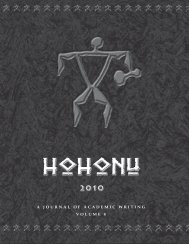A JOURNAL OF ACADEMIC WRITING VOLUME 5
A JOURNAL OF ACADEMIC WRITING VOLUME 5
A JOURNAL OF ACADEMIC WRITING VOLUME 5
Create successful ePaper yourself
Turn your PDF publications into a flip-book with our unique Google optimized e-Paper software.
and structured debates concerning artifacts and<br />
reburials if they were part of a sovereign Hawaiian<br />
government.<br />
A sovereign Hawaiian government, whether<br />
linked to the U.S. or not, is essential in the progression<br />
of the Hawaiian Islands. It would allow Hawaiians<br />
to collectively make decisions they can agree on, or at<br />
least be satisfied with the representation they receive<br />
for decision making. Issues regarding burial sites,<br />
ancient artifacts, land access for religious ceremonies,<br />
and Hawaiian Trust fund management would no<br />
longer be topics of public debate. Hawaiians, as<br />
an indigenous people, have a right to control these<br />
matters themselves (Haunani-Kay Trask 16). The<br />
desire for autonomy has been made evident by the<br />
creation of organizations such as Ka Lahui Hawai’i,<br />
Ka Pakaukau, Hui Malama and others. Now, Native<br />
Hawaiians are waiting for the political recognition<br />
they deserve.<br />
Hawaiians deserve sovereignty with the ability<br />
to break away from the U.S. if they choose. The list<br />
of grievances enacted upon the Hawaiian people by<br />
the U.S. government is long and extensive. Multiple<br />
political groups and organizations have already been<br />
formed in the pursuit of achieving sovereignty. It is<br />
now a question of when sovereignty will occur, rather<br />
than if it will occur. Ka Pakaukau seems like the<br />
best choice for sovereignty for the islands. It would<br />
allow for a gradual shift of power from a U.S. state<br />
to an independent nation. The measure would also<br />
probably take several years, which would give current<br />
residents enough time to decide whether to move or<br />
become citizens of the new nation. Most importantly,<br />
as an independent nation Hawai’i could control many<br />
aspects of life here that will shape the future of the<br />
islands. Leaders could set limits on immigration and<br />
tourism. This is crucial for slowing the degradation<br />
of the finite natural resources found in Hawai’i. The<br />
government could establish committees to discuss<br />
and decide issues concerning native interests such<br />
as burial rights and Hawaiian artifacts. A public<br />
relations committee could be created to promote<br />
realistic images of Hawai’i in the tourist industry.<br />
Most importantly, sovereignty would help give<br />
recognition and respect to the Hawaiian people. The<br />
knowledge that they control their own affairs would<br />
boost the confidence of the entire nation.<br />
A strong case has been made for Hawaiian<br />
sovereignty. There are many tough decisions that<br />
have to be made before sovereignty takes place.<br />
When it does take place, then Hawaiians can once<br />
again benefit from the land which raised them.<br />
55<br />
WORKS CITED<br />
Ayau, Edward Halealoha. “Native Burials: Human<br />
Rights and Sacred Bones.” Cultural Survival. 1-4.<br />
7 June 2001 .<br />
Conklin, Kenneth. “NAGPRA as applied to Hawai’i-<br />
Mokapu, Honokahua, Bishop Museum Ka’ai;<br />
Providence Museum Spear Rest; Forbes Cave<br />
Artifacts; the Hui Malama organization.”<br />
Angelfire.com 1-16. 7 August 2006 .<br />
Kamau’u, Mahealani and H.K. Bruss Keppeler.<br />
“What might sovereignty look like?” Price of<br />
Paradise. Vol. 2. Ed. Randall Roth. Honolulu:<br />
Mutual Publishing, 1992. 294-301.<br />
Keppeler, H.K. Bruss. “Why would the State pay over<br />
$100 million in damages to Hawaiians and still<br />
go along with demands for ‘sovereignty’?” Price<br />
of Paradise. Vol. 1. Ed. Randall Roth. Honolulu:<br />
Mutual Publishing, 1992. 195-203.<br />
Silva, Noenoe. “Kanaka Maoli Resistance to<br />
Annexation.” Oiwi: A Native Hawaiian Journal<br />
Dec. 1998: 40-73.<br />
Trask, Haunani-Kay. “Settler of Color and<br />
‘Immigrant’ Hegemony: ‘Locals’ in Hawai’i.”<br />
Amerasia Journal 26:2 (2000): 1-24.<br />
Trask, Mililani. “Ka Lahui Hawai’i: A Native<br />
Initiative for Sovereignty.” Turning the Tide:<br />
Journal of Anti-Racist Activism, Research and<br />
Education 6 (1993): 5-6. 25 Nov. 2006 < http://<br />
www.Hawai’i-nation.org/turningthetide-6-4.<br />
html>.<br />
This paper was written for English 100.
















